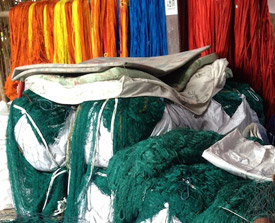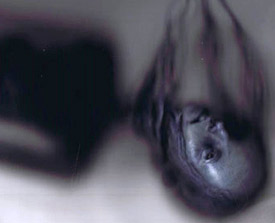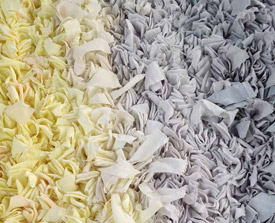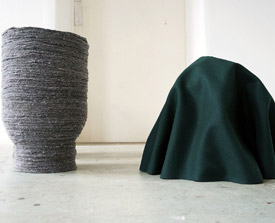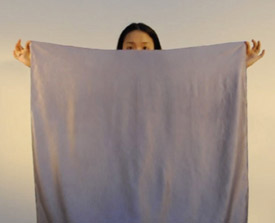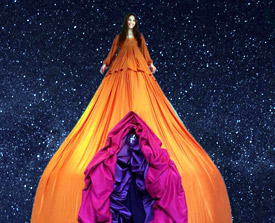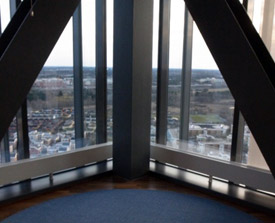Konstfack Degree Exhibition 2015 / Vårutställning 2015
We are extremely proud to present this year’s graduating students from the master’s programme Textile in the Expanded Field.
Through seminars, discussions, experimental theoretical and practical formulations, as well as various publication formats, the students have spent two years deepening their practices within the textiles field. Many of this year’s projects have sprung from social practices, in which questions regarding identity, interpretation rights and moral courage are considered in the meeting with people in different contexts and using different methods. This year’s master’s students show the multifaceted possibilities of the textiles field: from investigations of the actual material as a visual catalyst, to its political potential and communicative possibilities.
Textiles are a constant presence in our everyday lives and history as the link between our skin and the world, as a status symbol, as a class marker and struggle, as a material of desire and lust, and as a surface for economic transactions. The close relationship between humans and textiles makes investigations within this area continually current and relevant, and it is difficult, near impossible, to imagine a human world without the presence of textiles.
The Konstfack Degree Exhibition is the start of these students’ professional lives, and the meeting with the audience forms an important foundation for their future practices.
We present:
Linnea Blomgren, whose work focuses on the acoustic environment. With her long experience in working with woven objects, she approaches the acoustics of a room, and the growing need to create spaces within it dedicated to concentrated work. Using the weave as a point of departure, Linnea Blomgren creates contemporary sound absorbents, in which aesthetics and function interact.
Chamaikarn Chartsiri uses traditional techniques to tie fishnets, and creates contemporary furniture to sit on, which tells the story of fishermen and dying handicraft techniques. Her story begins in a Thai fishing village, and moves through the world to Swedish fishermen and fishnet techniques, and to conceptual design, where she finally gives a new framework to the Swedish “fika” [coffee and cake].
Sofie Rykowski works with site-specific performances, which is based on text materials with textiles as a common theme. Her work explores questions of moral, collective and individual responsibility, based in Shakespeare as well as sociology. The lines between participation and audience, and the artist’s role and relation to the composition of the group are central themes.
Sara-Lo Serra wishes to honour and raise the view of female genitals through a work that combines various contemporary and historical rituals with textile sculptures and scenographic possibilities. Her work takes the participant on a journey through the history of the female sex in different times and countries.
Emilie Steele uses the contemporary and historical views of mental illness to create sculptural works, investigating the fear of touching those who are “sick”. Her works challenge the boundary between what is beautiful and what is frightening, taking their point of departure from Japanese anime, fashion and sculpting techniques.
Mi Tjio uses the scarf as a starting point of an investigation of hybrid identities and prejudice. Using contemporary information channels, such as YouTube, she explores what connotations different ways of tying the same scarf can have.
Maria Westmar works with installations that challenge our vision. Everyday objects found at random meet objects created with precision, their common properties being movement and reformation. The objects often have their origin in manufacturing and industrial production.
Welcome!
Bella Rune, Professor of Textiles
Katarina Sjögren, Guest Lecturer
Vi är mycket stolta över att presentera årets avgångsstudenter från masterprogrammet Textile in the Expanded Field.
Genom seminarier, diskussioner, experimentella formuleringar i teori och praktik och olika publiceringsformer, har studenterna fördjupat sina praktiker inom de textila fälten under två år. Många av årets arbeten har sina ursprung i sociala praktiker, där frågor kring identitet, tolkningsföreträde och civilkurage gnuggas genom möten med människor i olika sammanhang och med olika metoder. Årets masterstudenter visar på det textila områdets mångfacetterade möjligheter, från undersökningar i materialet i sig som en katalysator för seendet, till dess politiska potential och kommunikativa möjligheter.
Textil är ständigt närvarande i vår vardag och historia, som länken mellan huden och världen, som statussymbol, som klassmarkör och strävan, som material för åtrå och lust och som yta för ekonomiska transaktioner. Människans nära relation till textil gör undersökningar inom området ständigt aktuella och relevanta, det är svårt, nästan omöjligt, att tänka sig en mänsklig värld utan textil närvaro.
Vårutställningen är början på studenternas professionella liv och mötet med publiken bildar ett viktigt fundament för deras framtida praktiker.
I Linnea Blomgrens arbete står ljudmiljön i fokus. Med lång erfarenhet av att arbeta med vävar, tar hon sig an rummets akustik och det växande behovet av att skapa rum i rummet för fokuserat arbete. Med väven som utgångspunkt skapar Linnea Blomgren samtida ljudabsorbenter där estetik och funktion samspelar.
Chamaikarn Chartsiri utgår från traditionella tekniker för att knyta fisknät och skapar samtida sittmöbler som berättar historier om fiskare och hantverkstekniker som är på utdöende. Hennes berättelse startar i en thailändsk fiskeby och rör sig genom världen till svenska fiskare och fisknätstekniker, till konceptuell design där den svenska ”fikan” ges en ny inramning.
Sofie Rykowski arbetar med platsspecifika performances som utgår från textmaterial där textilen är en röd tråd. Hennes verk utforskar frågor om moral och gemensamt och individuellt ansvar, med en grund i såväl Shakespeare som sociologi. Gränserna mellan deltagande och publik och konstnärens roll och relation i gruppens sammansättning är centrala frågor.
Sara-Lo Serra vill hedra och höja synen på kvinnans kön i ett arbete som fogar samman olika samtida och historiska riter med textila skulpturala och scenografiska möjligheter. Hennes arbete tar deltagaren på en resa genom kvinnokönets historia i olika tider och länder.
Emilie Steele utgår från den samtida och historiska synen på psykisk sjukdom och skapar skulpturala verk, där rädslan för att vidröra den ”sjuka” undersöks. Hennes verk utmanar gränsen mellan skönhet och det skrämmande, men utgångspunkt i japansk anime, mode och skulpturala tekniker.
Mi Tjio använder sjalen som startpunkt för en undersökning om hybrididentitet och fördomar. Med samtida informationskanaler, som YouTube, som en av grundpelarna utforskar hon vilka konnotationer olika sätt att knyta samma sjal medför.
Maria Westmar arbetar med installationer i vilka vårt seende utmanas. Upphittade vardagsföremål möter precisionsmässigt skapade objekt med rörelse och omformande som gemensamma egenskaper. Objekten har ofta en grund i tillverkning och industriell produktion.
Välkomna!
Bella Rune, professor i textil
Katarina Sjögren, gästlärare
